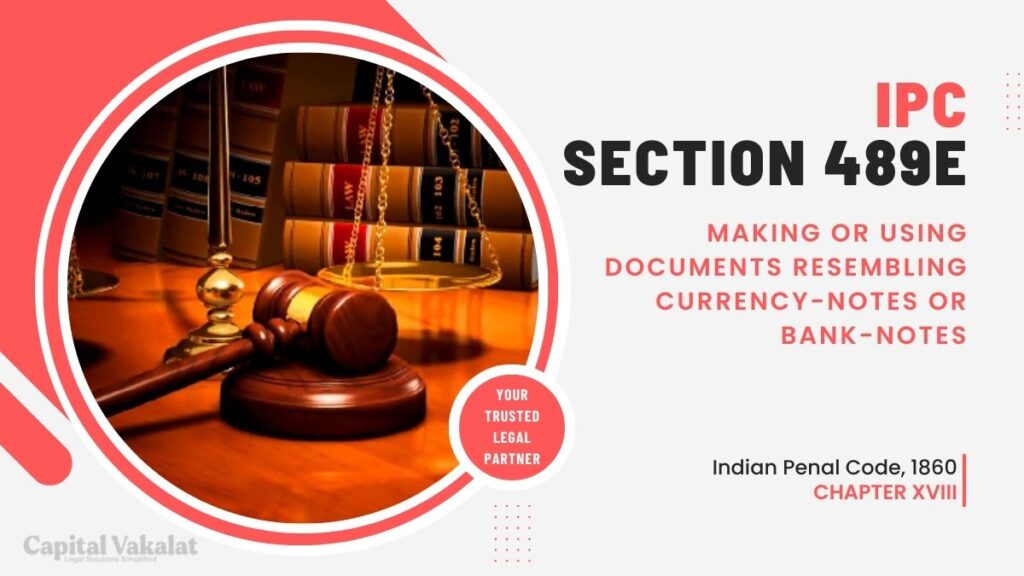Counterfeiting currency is a serious offense that undermines the stability of financial systems and poses a threat to the integrity of economies worldwide. In India, the legal framework addressing this issue includes Section 489E of the Indian Penal Code (IPC).

This article explores the nuances of Section 489E IPC, shedding light on the making or using of documents resembling currency-notes or bank-notes and its implications.
Understanding Section 489E IPC
Section 489E of the IPC is a crucial piece of legislation that specifically deals with the creation and use of documents resembling currency-notes or bank-notes. The primary objective is to curb activities that can compromise the authenticity of legal tender. It encompasses various forms of documents that may be used to deceive the public or financial institutions.
Prohibitions and Offenses
To comprehend the gravity of Section 489E IPC, one must understand the explicit prohibitions it lays out. Any individual involved in making or using documents that resemble currency-notes or bank-notes with the intention of deceiving others commits an offense under this section. The penalties for such offenses can range from fines to imprisonment, depending on the severity of the crime.
Historical Context
Currency counterfeiting is not a new phenomenon; it has evolved alongside advancements in printing technology. Examining the historical context provides insights into the measures societies have taken to address this issue. Section 489E IPC is a testament to the legal system’s adaptability to changing circumstances.
Impact on the Economy
The ramifications of counterfeiting on an economy are multifaceted. Beyond the immediate financial losses incurred by individuals or businesses, the erosion of trust in the currency can have far-reaching consequences. We delve into real-world examples of economies grappling with the aftermath of widespread counterfeit currency circulation.
Methods of Detection and Prevention
Technological advancements have equipped authorities with sophisticated tools to detect counterfeit currency. From watermark verification to the use of ultraviolet light, these methods have become instrumental in identifying fake notes. Additionally, preventive measures, such as the introduction of security features in currency design, play a pivotal role in curbing counterfeiting.
Famous Cases
Examining notable cases where Section 489E IPC has been invoked provides valuable insights. Understanding the circumstances, investigations, and outcomes of these cases offers a practical perspective on the challenges faced by law enforcement agencies.
Challenges in Prosecution
Despite legal frameworks in place, prosecuting individuals involved in counterfeiting remains a complex task. The global nature of currency circulation and the evolving techniques employed by counterfeiters present ongoing challenges for law enforcement. International cooperation becomes crucial in addressing these challenges effectively.
Public Awareness and Education
Creating awareness among the public about the implications of Section 489E IPC is vital for preventing the circulation of fake currency. Educational initiatives, both by governmental bodies and non-governmental organizations, play a significant role in ensuring that individuals can identify and report counterfeit currency.
Conclusion
In conclusion, Section 489E IPC serves as a bulwark against the threats posed by the making or using of documents resembling currency-notes or bank-notes. Its importance extends beyond legal frameworks, influencing public awareness, technological advancements, and international cooperation. Upholding the integrity of currency is a collective responsibility that requires continuous efforts from both authorities and the public.
Frequently Asked Questions
How can individuals verify the authenticity of currency notes?
Individuals can use various methods, including checking security features and consulting official guidelines, to verify the authenticity of currency notes.
What role do banks play in combating counterfeit currency?
Banks play a crucial role in detecting and reporting counterfeit currency, working in tandem with law enforcement agencies.
Can unintentional possession of counterfeit currency lead to legal consequences?
Intent is a crucial factor in legal proceedings. Unintentional possession, without an intent to deceive, may not lead to severe legal consequences.
How often are new security features introduced in currency design?
Currency design evolves periodically, with central banks introducing new security features to stay ahead of counterfeiters.